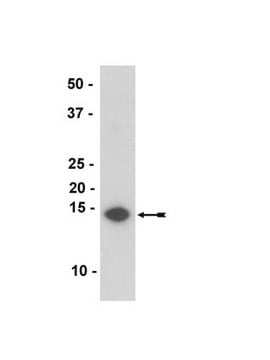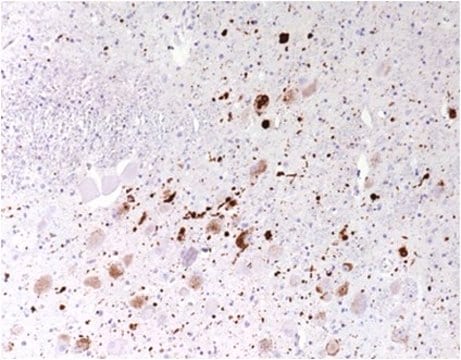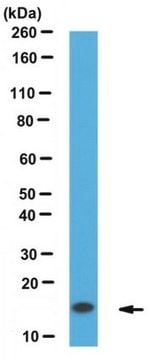MAB5320
Anti-Synuclein α Antibody, clone 7B12.2
culture supernatant, clone 7B12.2, Chemicon®
Sign Into View Organizational & Contract Pricing
All Photos(3)
About This Item
UNSPSC Code:
12352203
eCl@ss:
32160702
NACRES:
NA.41
Recommended Products
biological source
mouse
Quality Level
antibody form
culture supernatant
antibody product type
primary antibodies
clone
7B12.2, monoclonal
species reactivity
human
manufacturer/tradename
Chemicon®
technique(s)
immunohistochemistry: suitable
western blot: suitable
isotype
IgG
NCBI accession no.
UniProt accession no.
shipped in
dry ice
target post-translational modification
unmodified
Gene Information
human ... SNCA(6622)
Specificity
Reacts with alpha Synuclein. By Western blot the antibody shows no reactivity with beta or gamma synuclein. This antibody was shown to stain Lewy bodies in frozen section of human brain with Parkinson′s disease and glial inclusions in frozen section of human brain with Multiple System Atrophy.
Immunogen
Recombinant human alpha synuclein.
Application
Anti-Synuclein Antibody, α, clone 7B12.2 detects level of Synuclein & has been published & validated for use in IH & WB.
Research Category
Neuroscience
Neuroscience
Research Sub Category
Neurodegenerative Diseases
Neurodegenerative Diseases
Western blotting on recombinant alpha synuclein: 1:2,000-1:4,000.
Lane 1: Recombinant human alpha synuclein
Lane 2: Recombinant human beta synuclein
Lane 3: Recombinant human gamma synuclein
Immunohistochemistry (frozen sections): 1:250-1:500
Optimal working dilutions must be determined by end user.
Lane 1: Recombinant human alpha synuclein
Lane 2: Recombinant human beta synuclein
Lane 3: Recombinant human gamma synuclein
Immunohistochemistry (frozen sections): 1:250-1:500
Optimal working dilutions must be determined by end user.
Target description
15-18 kDa
Linkage
Replaces: 04-1053
Physical form
UnPurified tissue culture supernatant from a perfusion system, filtered through a 0.2μ micron membrane prior to vialing. Product contains 20%FBS and Ciprofloxacin at final concentration of 10μg/mL.
Unpurified
Storage and Stability
Maintain for 1 year at -20°C from date of shipment. Aliquot to avoid repeated freezing and thawing. For maximum recovery of product, centrifuge the original vial after thawing and prior to removing the cap.
Analysis Note
Control
Brain tissue
Brain tissue
Other Notes
Concentration: Please refer to the Certificate of Analysis for the lot-specific concentration.
Legal Information
CHEMICON is a registered trademark of Merck KGaA, Darmstadt, Germany
Disclaimer
Unless otherwise stated in our catalog or other company documentation accompanying the product(s), our products are intended for research use only and are not to be used for any other purpose, which includes but is not limited to, unauthorized commercial uses, in vitro diagnostic uses, ex vivo or in vivo therapeutic uses or any type of consumption or application to humans or animals.
Not finding the right product?
Try our Product Selector Tool.
recommended
Product No.
Description
Pricing
Storage Class Code
10 - Combustible liquids
WGK
WGK 1
Flash Point(F)
Not applicable
Flash Point(C)
Not applicable
Certificates of Analysis (COA)
Search for Certificates of Analysis (COA) by entering the products Lot/Batch Number. Lot and Batch Numbers can be found on a product’s label following the words ‘Lot’ or ‘Batch’.
Already Own This Product?
Find documentation for the products that you have recently purchased in the Document Library.
Francesca Sardone et al.
Journal of cellular physiology, 229(7), 878-886 (2013-12-21)
Cell-extracellular matrix interaction plays a major role in maintaining the structural integrity of connective tissues and sensing changes in the biomechanical environment of cells. Collagen VI is a widely expressed non-fibrillar collagen, which regulates tissues homeostasis. The objective of the
Nanoscale imaging of individual amyloid aggregates extracted from brains of Alzheimer and Parkinson patients reveals presence of lipids in I?-synuclein but not in amyloid I?1-42 fibrils.
Zhaliazka, et al.
Protein Science, 32, e4598-e4598 (2023)
Xichen Zheng et al.
The Journal of clinical investigation, 128(5), 2104-2115 (2018-04-18)
Immune checkpoint blockade (ICB) has demonstrated curative potential in several types of cancer, but only for a small number of patients. Thus, the identification of reliable and noninvasive biomarkers for predicting ICB responsiveness is an urgent unmet need. Here, we
Francesca Sardone et al.
Matrix biology : journal of the International Society for Matrix Biology, 55, 90-105 (2016-10-19)
In response to injury, tendon fibroblasts are activated, migrate to the wound, and contribute to tissue repair by producing and organizing the extracellular matrix. Collagen VI is a microfibrillar collagen enriched in the pericellular matrix of tendon fibroblasts with a
Lu-Yao Tong et al.
Frontiers in pharmacology, 13, 914153-914153 (2022-07-23)
The recovery of spinal cord injury (SCI) is closely associated with the obstruction of oligodendrocyte progenitor cell (OPC) differentiation, which ultimately induces the inability to generate newly formed myelin. To address the concern, drug-based methods may be the most practical
Our team of scientists has experience in all areas of research including Life Science, Material Science, Chemical Synthesis, Chromatography, Analytical and many others.
Contact Technical Service







